The Science Inside
Published 2 December 2021
Introduction by Doug Umbers, interim chief executive of Dstl
It is my great pleasure to welcome you to The Science Inside, a snapshot of impactful projects that we have delivered for UK Defence and Security over the past year.
Dstl’s world-class people are a proven Defence asset we can be all be proud of, whether it be acting as a trusted partner to demystify and harness the application of science and technology (S&T), offering credible, impartial, evidence-driven advice and solutions to the armed forces, police and security colleagues, or helping to create clear military and security advantage.
The past 12 months have again been challenging for the UK as we navigate our way out of the coronavirus pandemic and the threats from state and non-state adversaries continue to evolve at a frenetic pace. Despite these challenges, Dstl is playing its part in helping the UK and its allies stay ahead of those who wish us harm and threaten our way of life.
We are giving greater emphasis to research into artificial intelligence, autonomy, cyber, novel weapons and space in support of the ambitions outlined by the Prime Minister in the Integrated Review of Security, Defence, Development and Foreign Policy and the MOD’s Chief Scientific Adviser’s 5 capability challenges.
We are also casting our net further to find, nurture and fund generation after next technologies that have the potential to give the UK the edge, boosted by an additional £1 billion on Defence S&T research.
But we are also maintaining our hard-earned expertise across 22 S&T capability areas delivering 4 main outputs:
- Research: original research and concepts, creating new capabilities for Defence and Security
- Requirements and Evaluation: S&T support to assess, evaluate and deliver current, next and generation after next capabilities
- Specialist Advice and Services: knowledge and facilities at readiness to meet priority needs
- Operational Support: rapid and deployed S&T to meet the urgency of operations
We’re growing our supply base from industry and academia so that we benefit from the very best innovation that takes place outside of Government, while supporting levelling-up across the UK.
And our international partnerships with allies are becoming stronger as we look to secure our science superpower status.
In this, our 20th anniversary year, I’m delighted to share with you this inspiring glimpse at a small selection of the fascinating science and technology projects we are delivering at Dstl.

Doug Umbers, Interim Chief Executive, Dstl
Maritime
Integrating human-machine teams in the Intelligent Ship

Intelligent Ship demonstrates how automation, autonomy, machine learning and artificial intelligence (AI) can be closely integrated and teamed with humans, enabling more timely and better informed decision making and planning.
The programme de-risks and evaluates technologies and approaches to enable revolutionary future platform, fleet and cross-domain concepts to enhance UK military advantage. Now in its second phase, projects are underway to support the evaluation and demonstration of a range of human-machine teams, or Agents for Decision-Making (ADeMs), and their integration with an evaluation environment (the Intelligent Ship Artificial Intelligence Network - ISAIN).
During Exercise Formidable Shield Dstl brought AI into the command spaces on a Type 45 destroyer (HMS Dragon) and Type 23 frigate (HMS Lancaster) for the first time.
STARTLE® from Roke continuously and autonomously detects contacts that exhibit anomalous or suspicious behaviours and creates operator alerts to enable early action against threats.
SYCOIEA from CGI supports Threat Evaluation and Weapon Allocation (TEWA) operators in high tempo operations, including the assessment of track identity, classification and certainty of hostile intent and recommends sequences of effects against multiple threats.
This will crucially increase engagement timelines and provide the commanders with tools to support operational decision making.
Exploring the depths of uncrewed underwater vehicles

Image © MSubs
The pioneering Extra Large Uncrewed Underwater Vehicle (XLUUV) developed by MSubs Ltd is being used as a testbed for novel sensor and payload technology provided by commercial and academic partners in a unique at-sea experiment.
Funded by NavyX and the Defence Innovation Fund and delivered through DASA, XLUUV is testing on-board systems, sensors and payloads required to support a range of scenarios to help develop the Royal Navy’s understanding of the utility and operational boundaries of uncrewed underwater vehicle systems.
This will help the Navy shape future requirements and design future capabilities and concepts of operation whilst providing innovators with the opportunity to develop and test aligned technology.
Radiography support to Carrier Strike Group’s 2021 deployment

Dstl conducted an Urgent Operational Requirement to the Royal Navy Fleet flagship, HMS Queen Elizabeth, to ensure radiation safety compliance ahead of the Carrier Strike Group deployment on Op FORTIS.
Dstl confirmed the suitability of the available ship compartments for medical radiography which supported the request for a more agile capability. The recent WESTLANT exercises demonstrated the utility of on-board radiography, with conservative estimates that more than £5 million could be saved by not having to evacuate personnel ashore for medical imaging. Dstl’s work means that the carrier’s radiography capability remains safe and compliant.
Pioneering WiFi under the waves
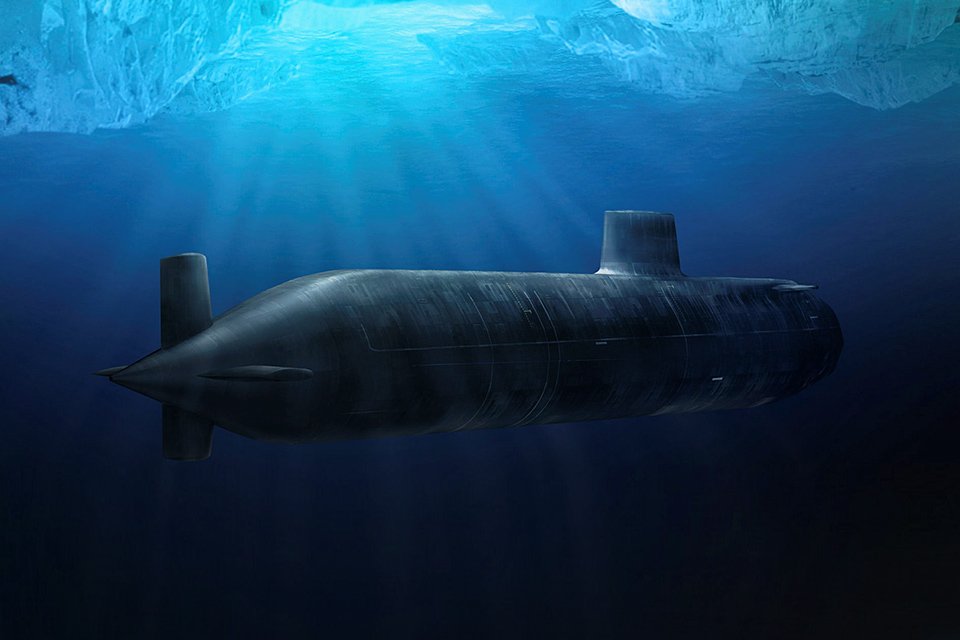
Dstl has pioneered a breakthrough in underwater communications technology – think secure WiFi for the ocean.
To lead this breakthrough, Dstl has worked collaboratively with the oil, gas and communications industries as well as academic leaders and other government departments.
At a recent trial, off the coast of Portugal, secure data exchange was demonstrated between a dived submarine and its support vessel at range. This was the first time an acoustic data exchange, using modern cryptographic principles, had been transmitted from a submarine. This technology, known as Phorcys, will be published as an open standard for worldwide use.
Safer future for mine disposal
Sea mine disposal could be transformed using innovative prototype technology being developed by Dstl, enabling minefields to be cleared more efficiently and quickly and enhancing freedom of operation without increasing risks to the disposal team.
Delivered underwater by a Remotely Operated Vehicle (ROV), Dstl’s Pulse Dart comprises a metal spike and tube. The spike penetrates the hard outer shell of the ordnance, where an electrical charge is applied to initiate the ordnance with the operative a safe distance away.
Air
Guiding future Air Mobility operations
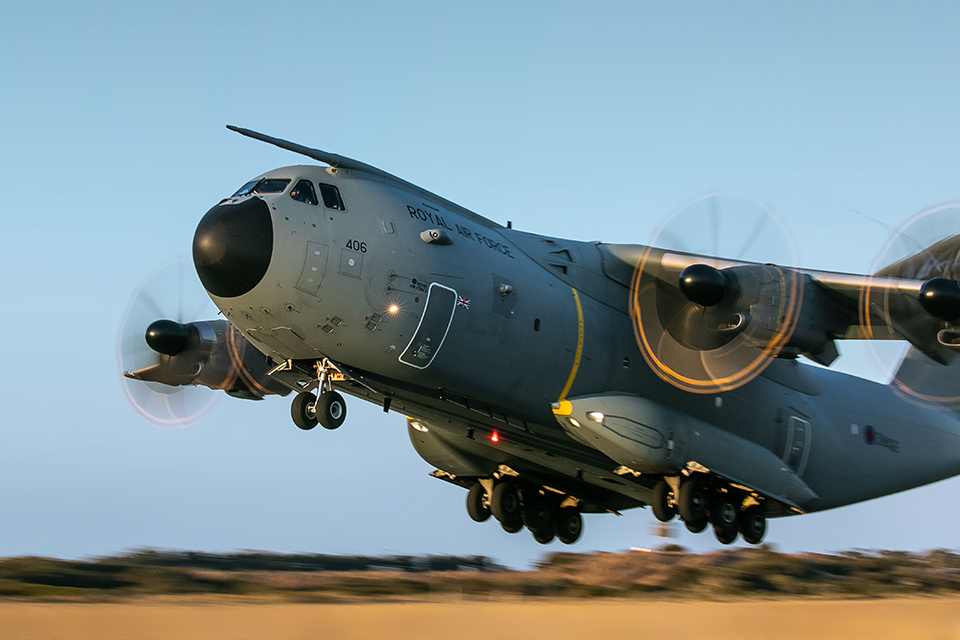
The Air Mobility fleet is the workhorse of the Royal Air Force (RAF) and our operational researchers have supported a number of key decisions shaping its future. Our analysis is guiding the evaluation of Command Support Air Transport options, future Air Platform Protection, ATLAS C.1 (A400M) capability growth, and air-to-air refuelling requirements.
Delivering Future Combat Air Systems (FCAS)

Dstl support is critical to FCAS and the development of the RAF’s 6th generation combat air capability, assessing cost effectiveness and ensuring the delivery of strategic objectives.
Building on years of research, Dstl experts continue to lead the UK’s Team Tempest industry consortium through the development and maturation of key technologies and future fighter concepts. Dstl has delivered complex, high-end operator-in-the-loop ‘MOONBAT’ trials in Cutlass, our advanced air combat simulator, to understand the balance of capability required across the combat air system.
Dstl support to Lightweight Affordable Novel Combat Aircraft (LANCA) continues with Phase 2 of Project Mosquito to deliver a combat air uncrewed demonstrator and prove order of magnitude cost and time savings.
Countering Uncrewed Air Systems (UAS)
The introduction of UAS has been one of the most significant technological advances of recent years, posing an immediate threat to UK forces and resistance to available counter-UAS capability.
Dstl is developing, demonstrating and evaluating viable capabilities to detect, track, identify and defeat hostile UAS across a range of defence situations. The work embraces plans to mitigate future advanced artificial intelligence-based UAS singly and in swarms, and ensuring that the MOD has access to impartial, evidence-based advice based on counter-UAS capabilities.
Supporting operations against Daesh

Dstl analysts are continuing to support operational commands and deployed forces as part of the Global Coalition Against Daesh.
During Op SHADER the RAF has conducted more than 1,000 airstrikes over Iraq and Syria, using more than 4,300 weapons launched from Tornado, Typhoon and Reaper aircraft. The UK has flown more than 8,000 sorties providing strikes, surveillance and reconnaissance, air-to-air refuelling and transport.
Enabling Information Advantage for UK helicopters
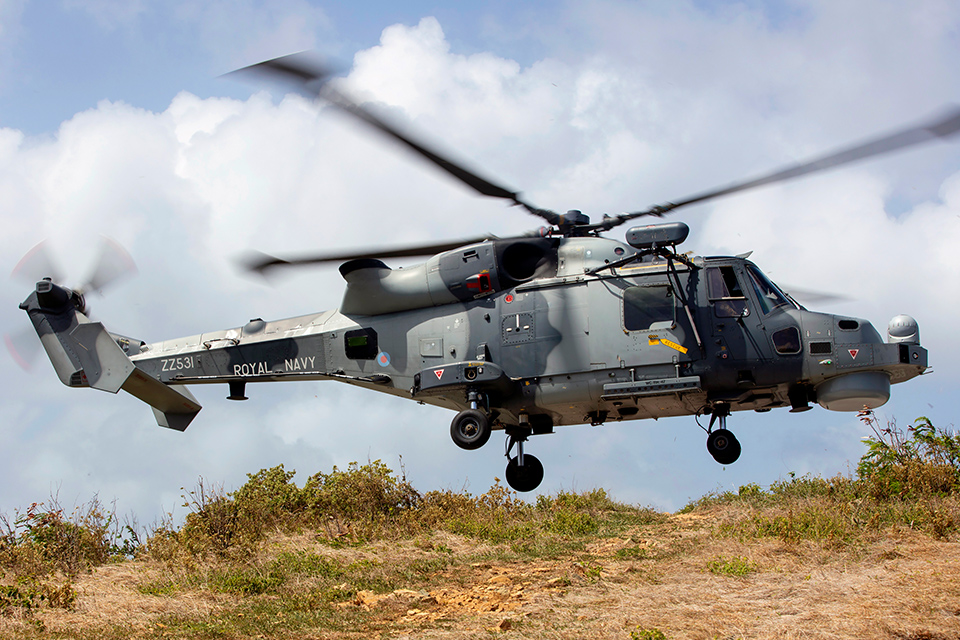
The UK’s primary Battlefield Reconnaissance Helicopter, Wildcat, has a requirement to disseminate data and information quickly and onto the future Intelligence, Surveillance, Target Acquisition and Reconnaissance (ISTAR) network.
Dstl was commissioned to deliver an integrated demonstration of Bowman BCIP 5.6 (providing both secure comms and the ability to exchange tactical information digitally) and Link 16 Tactical Data Link. Dstl contracted, provisioned and technically partnered with Leonardo Helicopters Division to provide a ground demonstration, prompting a rapid programme of work to deliver an airborne demonstration in 2022 and fleet-wide embodiment of the capability within the following years.
Delivering next generation Air Platform Protection (APP)

Dstl has worked collaboratively across MOD, with Government partners and industry towards a Sovereign APP Enterprise ready to deliver the Next Generation Air Survivability (NGAS) and maintain operational independence and freedom of access and manoeuvre.
Through an Urgent Capability Requirement, novel multi-part Infra-Red Countermeasures (IRCM) were provided to UK helicopters operating in support of Op SHADER, assured through a new digital Test and Evaluation approach.
In addition, Dstl partnered with the US F-35 Lightning II team on future IRCM capability, which will be assured through a blend of flight test and modelling and simulation. This has established the UK as an integral part of the team for through life capability support.
Land
Targeting the future

Working with industry partners SEA, Qioptiq and Lantac, Dstl’s Future Individual Lethality System (FILS) technology demonstrator programme delivered a next-generation prototype assault rifle with increased range, integrated data and power and a radically improved fused multispectral Surveillance and Target Acquisition system.
It is the first assault rifle capable of tasking third party effects, for example Remote Weapon Stations and Remotely Piloted Air Systems (RPAS). Further stages will explore integrated AI-enabled target detection and classification capabilities for passive range estimation and real time automated ballistic solution to increase the speed and accuracy of engagements.
New territory for wheeled demonstrator
Wheeled armoured vehicle mobility could break new ground with technologies being demonstrated on a one third scale Mobility Test Rig (MTR) invented by Dstl and QinetiQ to test functionality and capability.
The MTR features fully articulating active suspension, QinetiQ electric drive, advanced multi-wheel steer and wheel traction control. The unique platform will test solutions that provide a compact configuration for transportation or operation in urban areas, good stability at high speeds or on side slopes, enhanced step climbing, enhanced gap crossing, improved soft soil mobility and variable ride height that can be optimised for high ground clearance or low silhouette.
Countering IEDs

Dstl has played a major role in MOD’s £400 million CRENIC programme, which will deliver the next generation of electronic countermeasures to protect against improvised explosive devices (IEDs) for future force protection.
Dstl’s role involved designing an innovative technical architecture which includes common standards and promotes modular and reconfigurable solutions. The benefits of this include reducing the amount of time taken to upgrade as new technology becomes available, and enabling an ‘ecosystem’ of suppliers who can provide and incorporate new solutions as the capability develops. CRENIC has been held up as an example of best practice in the Defence and Security Industrial Strategy 2021.
UGVs breaking new ground
Dstl is conducting scientific assessment of the potential use of autonomous systems for resupply operations to understand how they will integrate with the wider defence logistics capability for the Army under the Joint Tactical Autonomous Resupply and Replenishment (JTARR) project.
This will inform the wider Project Theseus to “define and deliver an end-to-end, highly automated ground and air resupply network, enabled by a logistic information system; 24/7 and in all conditions.”
Separately, Dstl is exploring autonomous robotic solutions to detect life threatening chemical, biological and radiological (CBR) hazards. A demonstrator CBR sensor suite will be developed to be mounted on an uncrewed ground vehicle (UGV) to better understand the possible strengths and weaknesses of autonomous systems for CBR Recce and Survey and whether they can replace crewed vehicles.
New technologies span natural boundaries
Amphibious vehicles, bottom-crawling robots and drones with autonomous control are just 3 of the technologies being trialled under the Map the Gap competition, run by Dstl on behalf of DASA, to find new ways to help UK armed forces cross a body of water, or ‘wet gap’, safely and covertly while increasing the tempo of operations.
The prototypes are expected to retrieve vital information such as the depth and flow of the water, the distance between both banks and their respective heights and the ground-bearing capacity of the nearby land.
Diversity on the virtual battlefield
Diversity on the virtual battlefield
Dstl has been working with Slitherine Software and Battlefront to create a new version of Combat Mission that previously just featured white characters to represent groups from different ethnic backgrounds and use a more diverse set of accents to reflect today’s armed forces. The changes aim to open wargaming up to new audiences and ensure content is engaging and inclusive to all participants.
Largest military drone swarm
A swarm of 20 drones completed the largest collaborative, military focused evaluation of swarming uncrewed aerial vehicles (UAVs) in the UK.
The swarm consisted of 5 different types and sizes of fixed wing drones, with different operational capabilities, together with 6 different payload types, flying representative tasks. The UAVs flew simultaneous Beyond Visual Line Of Sight (BVLOS) cooperative tasks, with Blue Bear collaborative autonomy ensuring they all contributed to overall mission goals. The trial will inform and de-risk future choices and decisions about swarming drone capability.
Multi-Domain Integration
Spear delivers precision effects

Dstl played an instrumental part throughout the research and development of the new SPEAR3 surface-attack missile, from piloting new ways of working with industry to the technical assurance of the 7-year £550 million contract.
The team provided operational analysis and scientific know-how during assessment and, throughout the weapon development phase, offered assurance that the missile provides adequate lethality whilst minimising collateral damage.
Co-operative Strike Weapons
The Co-operative Strike Weapons Technology Demonstrator will explore how inter-missile communication can enable the weapons systems to work together and also improve the performance of current systems.
The project aims to increase the flexibility of missiles, ensuring that they can react to a changing threat or situation as it emerges and improve their responsiveness. It will change the way missiles operate together with an upgrade to the software system that allows this co-operative behaviour. If successful, UK platforms could be exploiting the benefits of a smarter integrated network of missiles within five years.
UK hosts international military urban experiment

Scientists at Dstl have led the first 5 Eyes nations urban military experiment in the UK, known as the Contested Urban Environment Exercise (CUE21).
The experiment in Portsmouth involved demonstrating novel and emerging Intelligence, Surveillance and Reconnaissance technologies to enhance forces’ situational awareness when operating in complex urban-littoral environments. Under the collaborative Technical Cooperation Program (TTCP), Dstl and its partners from the US, Canada, Australia and New Zealand worked alongside military personnel from the British Army and Royal Navy to assess the military benefits of prototype technologies. The findings from the experiment are being exploited across Defence to inform future capability development and experimentation activities.
C2 demonstrator trialled on NATO deployment
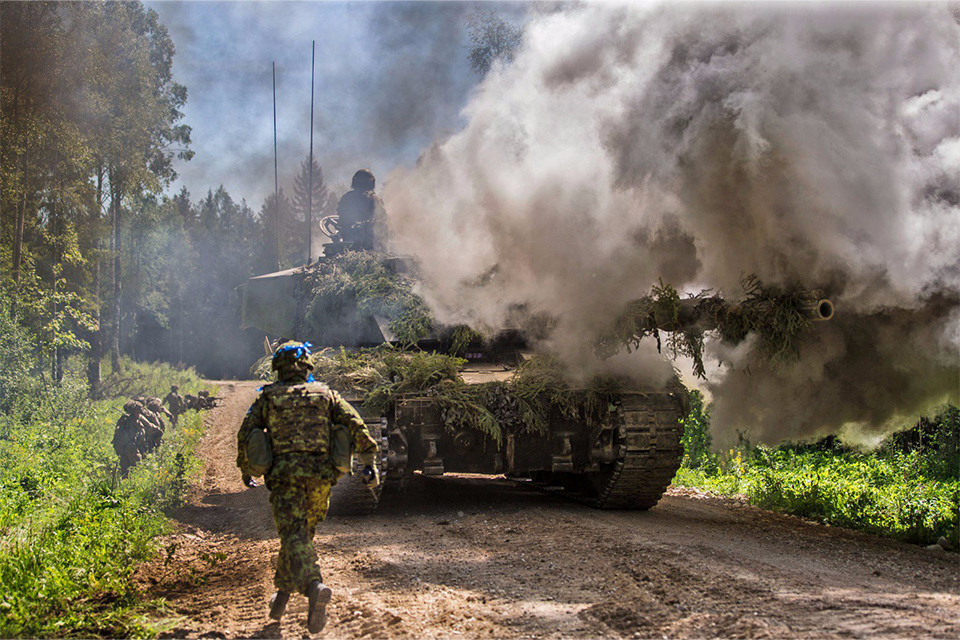
Dstl has evaluated an Operational Capability Demonstrator, designed to aid the transition of AI-related technologies into the hands of Command and Control (C2) practitioners. A UK planning cell experimented with the demonstrator while deployed on NATO’s Enhanced Forward Presence in Estonia and the assessment will inform further development.
Satellite imagery analysis boosted by automated object detection
Working as part of the Centre for Intelligence Innovation, Dstl has successfully delivered the first ‘SPOTTER’ operational concept demonstrator to Defence Intelligence (DI). SPOTTER applies deep learning based processing to classified satellite imagery, to provide an automated object detection capability to DI analysts. The aspiration is that the level of automation ultimately delivered by SPOTTER will transform image analysis by enabling target discovery and monitoring at a scale not currently possible.
£72.5m for novel weapons

Three contracts worth around £72.5 million have been awarded to UK industry to produce advanced laser and radio frequency demonstrators as part of the Novel Weapons Programme (NWP).
Known collectively as Directed Energy Weapons (DEW), these next-generation technologies could revolutionise the battlefield and reduce the risk of collateral damage. The systems are powered by electricity and operate without ammunition, significantly reducing operating costs, increasing platform endurance and providing unprecedented offensive and defensive flexibility to personnel on the frontline.
The first laser will undergo user testing on board a Royal Navy Type 23 frigate by detecting, tracking, engaging and countering Uncrewed Aerial Vehicles (UAV), whilst the British Army’s Wolfhound armoured vehicle will host a laser demonstrator that will investigate capability against UAV and other air threats. The radio frequency demonstrator will also be used by the British Army, hosted on a MAN SV truck to detect and track a variety of air, land and sea targets.
New techniques boost data exploitation
In collaboration with GCHQ and DI, Dstl has developed a range of techniques for text, imagery and video analysis, to improve the extraction of value from large datasets. Promising initial results with representative data have led to important enhancements in data sharing policy, which has allowed the team to progress to working with operational data in the subsequent phases of the research.
High speed weapons concepts take shape
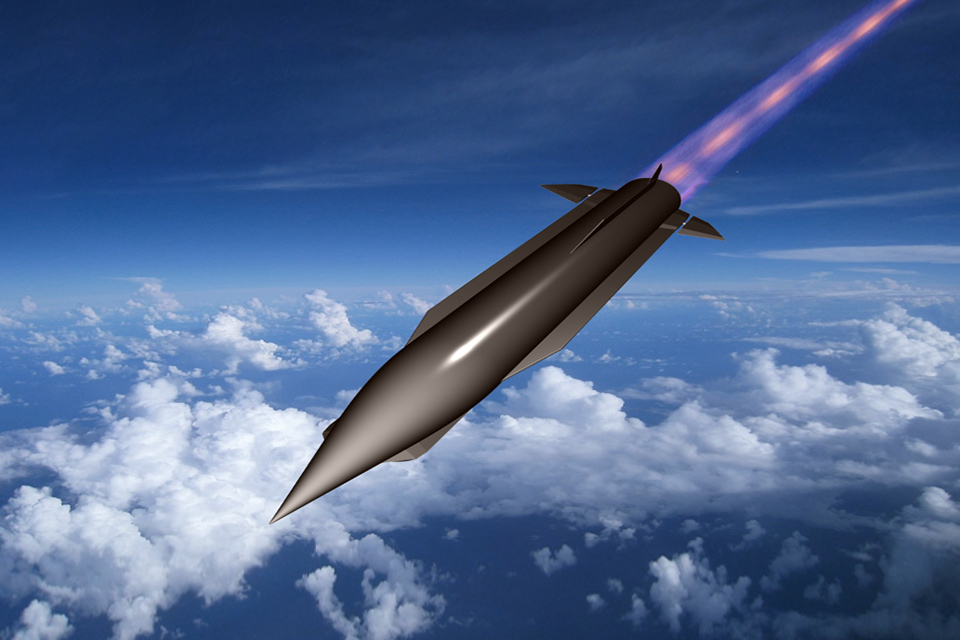
Dstl is developing high speed weapon and hypersonic concepts that can travel 5 times faster than the speed of sound.
With greater speed and increased range compared to current systems, high speed and hypersonic systems unlock the ability to engage new targets and reduce an adversary’s reaction time to respond. This will provide commanders with significant operational advantage, agility and reduce platform vulnerability.
Future weapons commonality

Image © MBDA
The Weapons Sector Research Framework (WSRF) contract is an Enterprise Approach collaboration between Dstl, industry and academia. Stakeholders work together, planning, tasking and delivering accelerated weapons S&T research.
Among work being carried out is the investigation of options and key enabling technology to provide the Army with next generation mounted and dismounted anti-armour weapon systems. A key aim is to enable platforms to accommodate any missile or rapid adaption to different missile systems, providing greater commonality and adaptability of future systems than at present. Through work being conducted within the WSRF, key technology is being developed to enable improved precision at an extended range with the ability to be deployed beyond line of sight or targeted remotely by third parties.
Cyber and Information Systems
Keeping the UK safe with National Cyber Force

Dstl is a key partner of the National Cyber Force (NCF), launched in April 2020.
Set up to transform the UK’s capacity in cyber operations against the likes of terrorists, criminal gangs and hostile states, the NCF draws together personnel from GCHQ, MOD, the intelligence services and Dstl for the first time under one unified partnership and command. By working in collaboration with NCF partners and capitalising on the breadth and depth of scientific specialisms within Dstl, the team has been able to meet the needs of NCF customers and operational requirements faster than ever before. Dstl’s scientific advice, capabilities and resources help keep the UK safe in an ever changing cyber world.
Resilient future for data centric security
Dstl has shown that Data Centric Security is viable and can be deployed in MOD systems to support coalition information sharing, using a combination of commercial off-the-shelf products and bespoke code.
Currently, information is primarily protected at the system level. Within the Information Based Security Approach data elements themselves are protected, signposting a more agile, resilient and secure future.
Operational support on defence from cyber-attack
Dstl researchers and analysts have provided expert advice on the protection from cyber-attacks of critical networks and facilities. Table-Top Exercises tested Cyber Mission Assurance under the Op AUGITE directive on Cyber Network Defence. Support to Op CEMETERY involved a cyber ‘pre-mortem’ to explore a series of catastrophic cyber scenarios to baseline MOD’s ability to respond and recover, informing future financial planning. Dstl personnel provided planning and operational support to Op FORTIS, the UK’s Carrier Strike Group 21 (CSG21) deployment, on defence from cyber-attack.
Avionics Research Test Bed supports Typhoon evolution
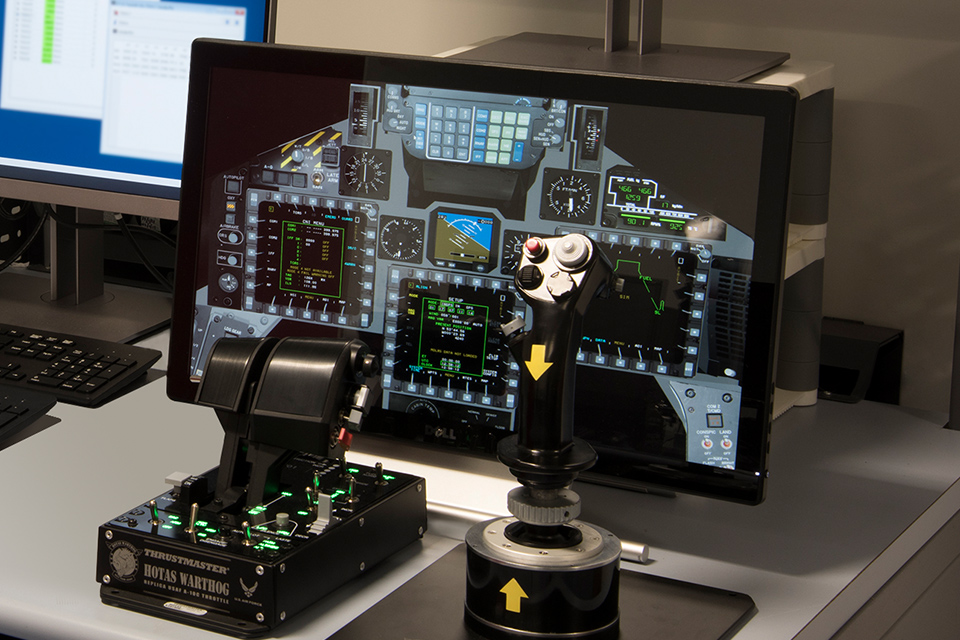
Dstl’s Avionics Research Test Bed has supported laboratory-based testing of NATO STANAG 7221 data buses to inform the UK’s position on high speed data network options within Typhoon’s Long Term Evolution (LTE) programme.
It has also been used to conduct cyber airworthiness research for the DE&S Airworthiness Team (DAT) and cyber defence research for an RAF customer.
Concepts for generation-after-next electromagnetic activities capability
A key enabler for future Multi-Domain operations will be the capability to conduct flexible and agile Electromagnetic Activities (EMA). Dstl has brought together a significant number of high level concepts to form an S&T perspective on the Generation After Next (GAN) enterprise capabilities for future EMA. These GAN concepts have been developed to stimulate discussion and act as a focal point to form a common understanding of where future defence EMA capability needs to be aiming.
Informing the Army’s electromagnetic future

Dstl is supporting FREERIDER, the Army’s Innovation, Research and Experimentation (IRE) activity, providing valuable learning opportunities for soldiers to develop best practice with the goal of establishing new ways of operating and an improved training pathway.
Current work is focused on providing a more mature hardware platform that conforms to open standards, as a stepping stone to exploitation through current and future equipment programmes. This will enable rapid adoption of new electromagnetic effects capabilities for the future Land force.
Space
Dstl science supporting UK Space Command

Dstl’s research is supporting UK Space Command, formed in April 2021, and the Government’s ambition that by 2030 the UK will have the ability to monitor, protect and defend our interests in and through space, using a mixture of national capabilities and burden-sharing partnerships with our allies.
Over the next decade the UK will spend an additional £1.4 billion on space to enhance our space domain awareness and develop a UK-built Intelligence, Surveillance and Reconnaissance satellite constellation and a supporting digital backbone in space.
Fast track global space innovation
The first International Space Pitch Day event was held as part of the Defence Space Conference. Co-funded with the US, through novel contracting it fast-tracked 10 innovation bids from India, Australia, US and the UK, building international cooperation and future capability.
Advancing space weather predictions
The Advanced Ensemble electron density Assimilative System (AENeAS) model has been selected for an operational capability as part of the Met Office Space Weather Operations Centre. MOD users will for the first time have a physics-based prediction of ionospheric conditions, which may challenge the operation of systems such as GPS, ultra-high-frequency satellite communications and radar.
Hermes controls first satellite
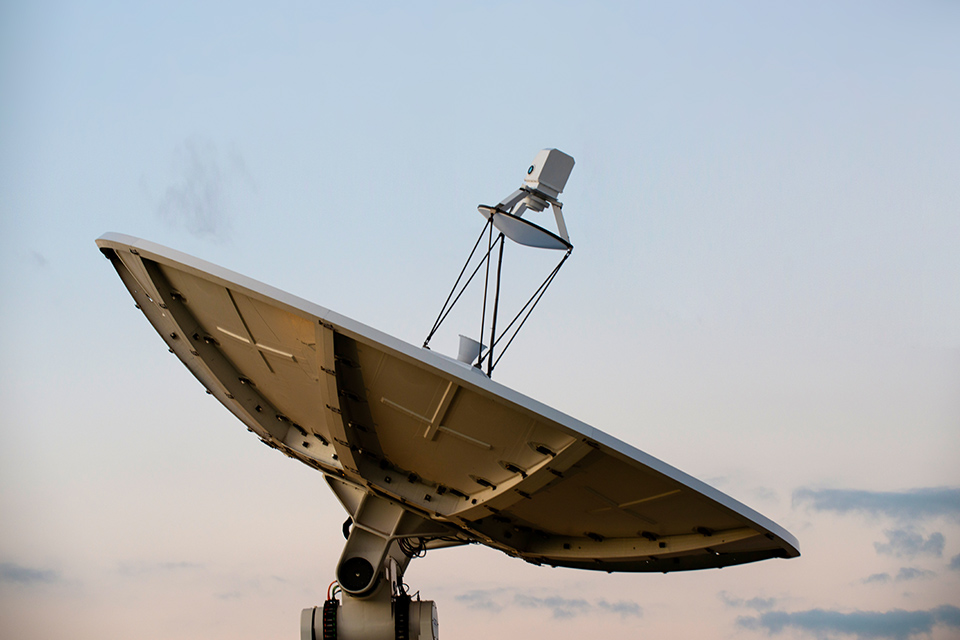
A major milestone in both the UK Government and Dstl’s space programme was achieved with the control of a satellite by a UK Government-owned ground-station for the first time in nearly 20 years.
Titania satellite demonstrator targets 2023 launch
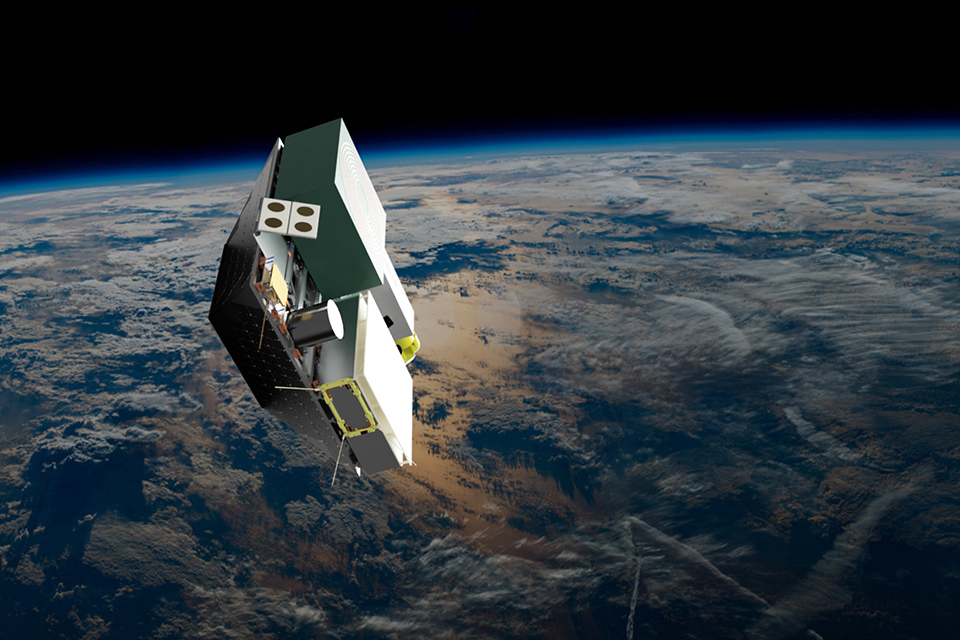
Dstl has awarded a £9.5 million contract to In-Space Missions to design and launch during 2023 a satellite to support the ‘Titania Operational Concept Demonstrator’. Titania is exploring the military utility of Low Earth Orbit (LEO) direct-to-earth free-space optical communications (FSOC) with its ability to transfer large volumes of data, at a low risk of detection or interception. Data is transferred at high speeds – up to 139 times faster than the average UK home broadband – via a narrow laser beam between 2 very specific points. Titania will communicate with ‘Puck’, Dstl’s new Optical Ground Station designed by QinetiQ, which will enable faster military decision making.
Policing and Security
Border Force

Following the tragic deaths of 39 people in a refrigerated trailer at Purfleet in 2019, Dstl has worked with the Border Force and Home Office Science to minimise the risk of such a tragedy reoccurring.
We assessed the potential of detection capabilities to find concealed people at UK and juxtaposed overseas ports. We conducted the UK’s first independent scientific assessment of body detection dogs and evaluated an innovative single-sided X-ray scanner in a van that can be driven past a row of trailers to generate images of their contents. The results were used to support Border Force’s procurement of five systems, which will be deployed in roles in mainland UK and at the Northern Ireland border.
Enhanced directional microphone

Dstl scientists have invented a novel audio technology that offers a significant improvement for surveillance systems. POPE is a new microphone array system – a system that focuses on sound from one direction – that uses Dstl-patented technology to increase performance and usability compared to existing solutions.
Key improvements include smaller size and portability for more discrete deployment, as well as improved audio quality, minimal unwanted noise pick-up and real-timelistening, all of which can support law enforcement investigations and operations. The patented technology behind POPE could also be used in other applications such as directional detection systems for gunshots or drones. Developed with Home Office funding, POPE is being commercialised by Ploughshare via a new start-up company and will be on the market in 2022.
Targeting malicious and illegal drones

Dstl is providing critical S&T support to address the risks posed by the malicious and illegal use of drones. Drone intrusion into airspace can cause massive disruption and present a serious risk to public safety and aviation security. Other potential misuse includes delivering contraband into prisons and smuggling, to privacy breaches and surveillance for criminal operations. Our work supports a ‘full spectrum’ approach to deter, detect and disrupt the misuse of drones.
Through the cross-government National Security Technology and Innovation Exchange, we are also ensuring that our security systems are effective against next-generation and generation-after-next drone technology.
Developing less-lethal weapons
In armed, public order and conventional policing scenarios, officers can be required to use force to deal with a threat to the public, bystanders or police, from violent or armed individuals. The force used to counter the threat must be reasonable, proportionate and necessary in the circumstances. The availability of less-lethal options could enable officers to resolve a situation prior to it escalating to a level where firearms would otherwise have to be used.
Working with the Home Office, police and Defence and Security Accelerator (DASA), Dstl has identified technologies that could allow law enforcement officers to safely prevent the escalation of conflict in serious or violent circumstances at a distance of up to 50 metres. The next stages of this work will result in further development of some of these technologies.
New concepts for tackling knife crime
Knife crime incidents have a devastating social and economic impact on victims and communities.
Dstl is working with external partners to develop new concepts and to explore non-traditional methods to aid police and security personnel in identifying concealed knives. Aided by market reviews and DASA competitions, Dstl’s efforts are now focused on developing operational concept demonstrators for detecting and discriminating knives at pinch points such as entrances to shopping centres or at ticket barriers in stations. Alongside this, Dstl is also supporting research into emerging innovations that could underpin future detection technology development.
Royal opening for Energetics Analysis Centre
Her Majesty The Queen, accompanied by the Duke of Cambridge, officially opened Dstl’s new Energetics Analysis Centre in October 2020.
The £30 million Energetics Analysis Centre (EAC) is a state-of-the-art building from which hundreds of scientists conduct world-class research and analysis to give the UK military and security advantage, protecting against terrorist and criminal threats. The EAC houses the Forensic Explosives Laboratory (FEL) which provides evidence and expert witness statements to support the British Criminal Justice System on explosives-related cases such as the Manchester Arena bombing.
The Queen and The Duke also saw Dstl’s Linear Accelerator (Linac), an incredibly powerful X-ray machine used for inspecting weapons and munitions. It is the only one of its kind in the UK for use on items containing explosives. The Linac allows the engineers and scientists to see inside explosive objects without disturbing them or taking them apart. It can produce an image through 250mm of steel, with a level of detail smaller than the thickness of a human hair.
Wider Defence and Cross-Government
Reducing danger with telexistence

Dstl has demonstrated innovative concepts that could give military personnel, emergency services or humanitarian workers the capability to carry out dangerous tasks in hazardous environments without physically being present.
Telexistence combines telepresence, robotics and haptic technologies to allow a user to experience being in a location many miles away as if they were there along with the ability to sense, touch, feel and interact with objects.
Dstl is working with the military and partners in DASA and the Nuclear Decommissioning Authority to develop and understand potential applications of telexistence technologies that keep our people out of harm’s way, ranging from bomb disposal and firefighting to space exploration, as well exploring the potential to increase performance and efficiency.
Blood drop evaluation

Blood loss is the leading cause of preventable death in battlefield casualties. A great deal depends on the importance of early treatment with blood products but there are logistical challenges.
The ‘blood drop’ testing and evaluation project, a collaboration between Dstl, Royal Centre of Defence Medicine, NHS Blood and Transplant and Joint Air Delivery Test and Evaluation Unit concluded that dropping packaged blood from an aircraft via parachute did not cause any additional deterioration to the blood. Many lives can now be saved on the frontline through the use of this innovation.
Looking through snowstorms
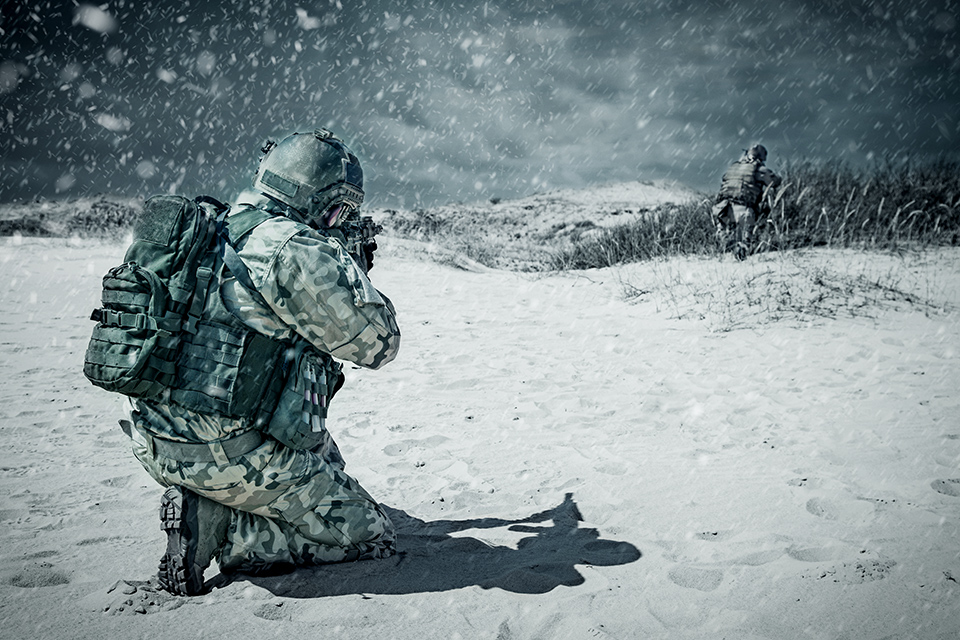
Dstl has worked collaboratively with international partner FOI Sweden to make technical steps forward to support future Defence operations by seeing in snowstorms and other degraded environments. Progress has been made by developing and testing new sensors, new models and new lasers to act like torches through snowstorms and clouds.
Sustaining equipment
Dstl testing and subsequent advice was provided to assess the on shelf-life of the current in-service CBRN Individual Protective Equipment (IPE) and support the management of in-service capability.
Underground sensing
Dstl has generated laser cooled rubidium atoms for the first time, a key enabling tool for a variety of sensing and timing applications, such as novel underground sensing and gravity map matching.
Seeing the future in Virtual Reality
Dstl’s virtual reality (VR) Museum of the Future provides a full VR experience telling the story of future possibilities and their importance. The museum demonstrates methods and tools to help the user to think differently and identify future threats in a novel way. The setting of the museum is based on the pillared hall in MOD Main Building and currently showcases work developed by Dstl including: Telling the story – short films, augmented reality equipment and stories – designed to bring ideas and concepts about the future to life; and Thinking differently – board games, card games and online ‘bots’ – designed to help users to consider other ways of providing insights about the future.
Supporting future MOD chemical detection capability development
Dstl supported two chemical detection Technical Demonstrator Programmes (TDP) funded by UK Strategic Command. TOASTMASTER focussed on location of deposited chemical hazards, and TITLEHOLDER focussed on warning for airborne chemical hazards. The output from TOASTMASTER and TITLEHOLDER will support the future MOD chemical detection capability development.
Radar windfarm mitigation

Seven projects have been awarded funding to develop technologies that support the coexistence of offshore windfarms and UK air defence (AD) systems. The DASA Windfarm Mitigation for UK Air Defence competition was run behalf on of the Department for Business, Energy and Industrial Strategy (BEIS) and the RAF to seek ideas from industry and academia to reduce the adverse impact that windfarms can have on AD and Air Traffic Control (ATC) surveillance systems.
Supporting the national coronavirus response
Dstl has played a crucial role to combat coronavirus and protect the health of the UK’s citizens. Our scientists responded to 785 requests and offers from across government and external companies or individuals seeking Dstl support. More than 300 scientists have worked on a wide variety of coronavirus projects including secondments throughout government. We created a PCR diagnostics laboratory to support military deployment, which reduced the burden on the NHS.
Our support included:
- Scientists deployed to hospital diagnostic laboratories around the country to help meet the government’s coronavirus testing targets;
- Analysts working across government, such as within the Cabinet Office, generated insights to be used for decision making, and within the Foreign, Commonwealth and Development Office to support international comparisons
- Developing a methodology that produced combined forecasts, R values and prevalence estimates, from the multiple academic estimates used by the Scientific Pandemic Influenza Group on Modelling (SPI-M) to inform the status of the epidemic.
Intellectual Property
Ploughshare’s innovation ambition
Ploughshare has announced ambitious plans to create hundreds of new ventures that will provide a substantial contribution to the economy and society. The new strategy is just part of a number of changes Ploughshare is making as part of a relaunch that sees it take on a renewed purpose and ambition to make more government innovations prosper.
Dstl research behind trial to predict sepsis
Clinicians at Portsmouth’s Queen Alexandra Hospital are leading medical trials of a blood test that could help to save thousands of UK lives a year by predicting sepsis days before patients show any symptoms. The test, originally researched over 10 years at Dstl, is now being developed by government spin-out company Presymptom Health, which believes it could save billions of pounds globally and improve clinical outcomes for sepsis patients.
We Are Dstl
Find out more about the Defence Science and Technology Laboratory, the science inside UK defence and security, at www.gov.uk/dstl, or contact us:
- Phone: +44 (0) 1980 950000
- Email: [email protected]

